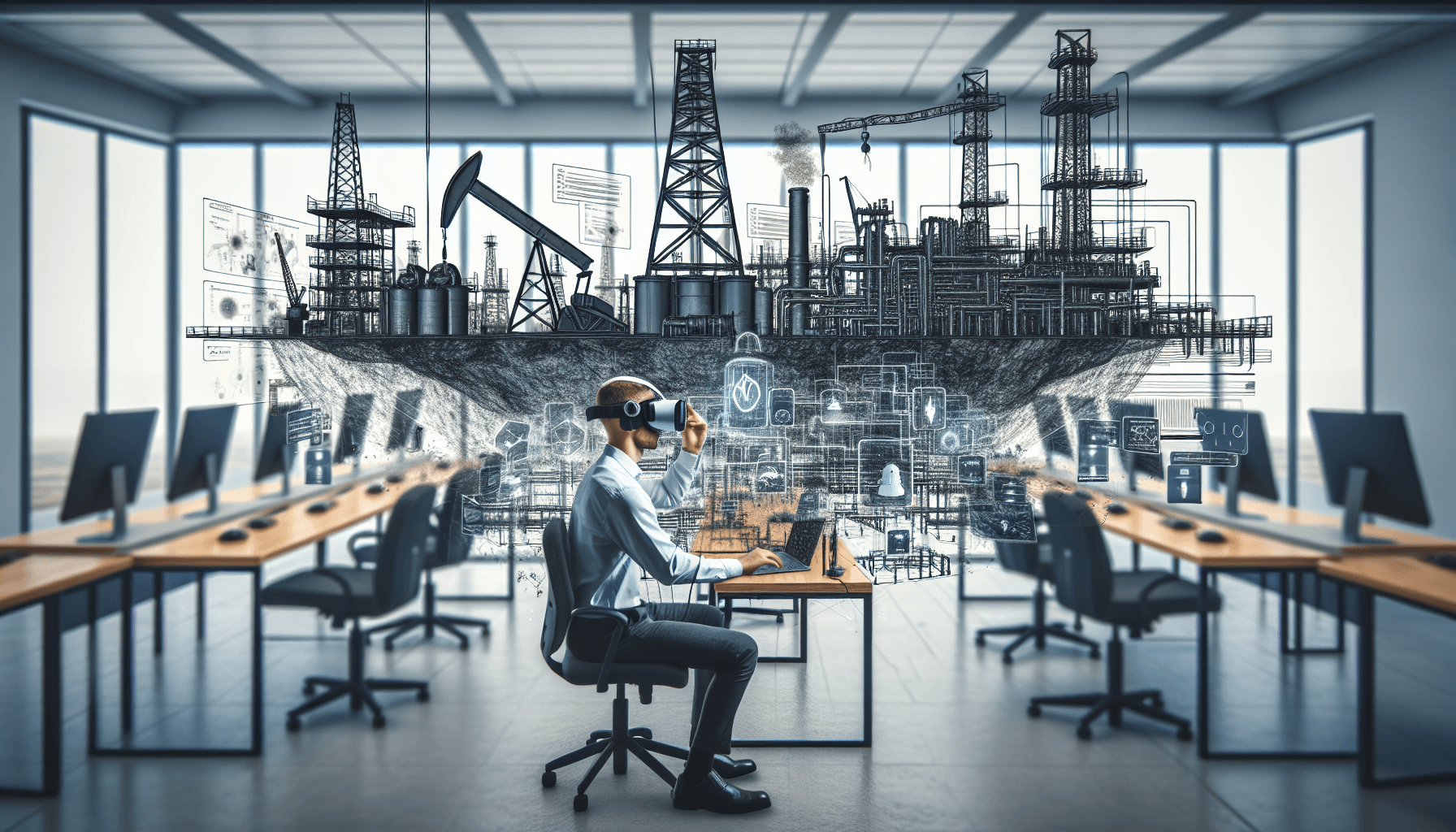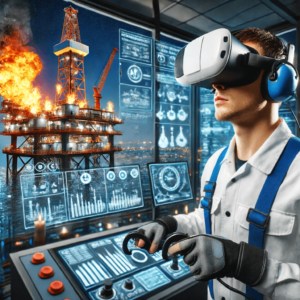In an industry where safety and efficiency are paramount, the advent of VR oil training has marked a revolutionary shift. This innovative approach not only enhances the traditional methods of employee training in the oil industry but also introduces a high level of interactivity and realism that was previously unattainable. The significance of integrating VR safety training solutions and custom VR training into the oil and gas sector cannot be overstated. By simulating real-world situations in a controlled environment, VR oil and gas training prepares employees for on-field challenges like never before, ensuring both their safety and productivity.
This article delves into the benefits of VR training in the oil and gas industry, highlighting how VR safety training software and oil and gas training software contribute to operational success. It will explore various applications of VR training oil and gas, including how it can be tailored through custom VR training to meet specific needs. The discussion will further extend to the practical aspects of implementing VR oil and gas VR training solutions effectively. By providing a comprehensive overview, the article aims to illuminate the impact and advantages of adopting VR training solutions within the oil and gas sector, setting a new standard for employee training and operational excellence.
Benefits of VR Training in the Oil and Gas Industry
Enhanced Safety and Risk Management
Virtual Reality (VR) Safety Training solutions significantly enhance safety by allowing oil and gas workers to engage in realistic simulations of potentially hazardous situations without actual risk. These simulations enable employees to practice and refine their skills in handling fires, explosions, and machinery operations, which are crucial for ensuring workplace safety and preventing accidents. Additionally, VR training facilitates emergency drills and crisis management exercises, helping workers to respond effectively in real-world scenarios.
Improved Training Efficiency and Skills Retention
VR training is highly effective in improving the efficiency of training programs and the retention of skills. Trainees can learn and master operational procedures through repeated practice in a controlled virtual environment, which helps in retaining knowledge longer and applying it more quickly in actual situations. The immersive nature of VR also ensures that trainees receive immediate feedback on their actions, which enhances learning and skill retention.
Cost Reduction and Scalability
Implementing VR training solutions can lead to significant cost savings for oil and gas companies. By reducing the need for physical training facilities and equipment, as well as cutting down on travel expenses, VR training minimizes the financial burden associated with traditional training methods. Additionally, VR allows for scalable training sessions that can be easily adjusted to accommodate varying numbers of employees without additional costs.
Increased Accessibility and Flexibility
VR training offers unparalleled accessibility and flexibility, enabling a diverse and global workforce to access high-quality training materials from any location. This remote accessibility supports continuous learning and collaboration among teams spread across different geographies. Furthermore, VR training can be tailored to fit the specific needs of each trainee, providing personalized learning experiences that are both effective and engaging.
Applications of VR Training in Oil and Gas
Simulated Hazard Identification and Risk Assessment
VR training enables oil and gas employees to identify and assess risks in a lifelike environment, enhancing their ability to proactively mitigate dangers and improve safety. This training includes vivid recreations of scenarios such as chemical leaks and faulty equipment, which hone workers’ skills in detecting and responding to hazards effectively.
Additionally, this immersive approach allows for the simulation of rare but critical incidents that might be too dangerous or impractical to recreate in reality. By experiencing these high-risk situations in a controlled virtual setting, employees can practice and perfect their emergency response procedures without real-world consequences. This not only boosts their confidence and preparedness but also fosters a deeper understanding of the complexities involved in managing such crises, ultimately leading to a safer and more resilient workplace.
Training for Equipment and Machinery Operation
Through VR simulations, workers can safely familiarize themselves with the operation of heavy machinery and equipment, practicing operational procedures and troubleshooting without real-world risks. This hands-on approach aids in precision and skill acquisition essential for safe and efficient field performance.
VR training can be customized to replicate specific scenarios and machinery models, ensuring that workers receive relevant and comprehensive training. This adaptability allows for continuous updates and improvements in training programs, keeping pace with technological advancements and regulatory changes.
Emergency Response Drills
VR technology facilitates realistic emergency drills where employees can practice response procedures, evacuation routes, and crisis management. These immersive training sessions are crucial for preparing workers to handle high-pressure situations effectively, enhancing overall preparedness and safety.
By training for emergencies, companies can prevent situations in which a drilling rig might need to shut down operations, thereby avoiding significant financial losses. Realistic simulations ensure that employees are well-prepared to tackle emergencies before they happen, allowing for quick and efficient responses that minimize downtime and protect both personnel and assets. This proactive approach not only safeguards the workforce but also sustains operational continuity, reinforcing the importance of thorough emergency preparedness.
TrainBeyond specializes in virtual reality (VR) training development specifically tailored for the oil and gas sector. Our cutting-edge VR solutions are designed to enhance safety and operational efficiency within this high-risk industry. We offer a comprehensive free trial that includes immersive training modules focused on emergency preparedness. This trial covers critical scenarios such as fire emergencies, hydrogen sulfide (H2S) leaks, and oil spills in a drilling land rig environment. By simulating these hazardous situations, TrainBeyond ensures that personnel are well-prepared to handle real-life incidents, thereby significantly reducing risks and improving overall safety standards.
Implementing VR Training Solutions
Assessing Training Needs
Identifying specific safety training requirements is crucial to determine where VR can have the most impact in the oil and gas sector. This initial assessment helps in tailoring VR solutions that address the precise needs of the industry.
Choosing the Right VR Technology
Selecting the appropriate VR technology involves choosing or developing VR training programs that are specifically designed for the unique demands of the oil and gas industry. This selection process is vital for ensuring the effectiveness of the training solutions.
Integration and Training of Staff
Comprehensive training for employees is essential to ensure their comfort and proficiency with VR technology. This step involves not only educating staff on how to use the VR systems but also integrating these technologies seamlessly into existing training frameworks.
Continuous Evaluation and Updates
Regular updates and continuous assessment of the VR training programs are necessary to keep them relevant and effective. This involves gathering feedback, evaluating the effectiveness of the training, and making necessary adjustments to improve the training solutions.
Conclusion
Throughout this discussion, we have navigated the transformative effects of VR training within the oil and gas sector, touching on enhanced safety protocols, improved training efficiency, and the financial benefits that these technologies offer. Additionally, the adaptability of VR training, facilitating remote access and personalized learning experiences, amplifies its value in fostering a skilled, versatile workforce primed for the multifaceted challenges of the industry. By delving into specific applications—from hazard identification to soft skills development—we’ve underscored the comprehensive scope of VR’s impact on operational excellence and safety management.
As we conclude, it’s clear that the integration of VR in oil and gas training represents a significant leap forward in how training is envisioned and executed. This evolution not only prepares employees more effectively for the complexities of their roles but also sets a new benchmark for safety and efficiency in the sector. Looking ahead, the continual refinement and expansion of VR training programs underscore an exciting frontier for professional development in the oil and gas industry, heralding a future where immersive technology drives unprecedented improvements in workforce preparedness and operational safety.
FAQs
- How is VR utilized in the oil and gas sector?
Virtual Reality (VR) and Augmented Reality (AR) are utilized in the oil and gas industry to enhance collaboration by virtually verifying assembly and manufacturing processes. Teams can leverage 3D facility models for virtual walkthroughs and project layouts, which aids in improving the bidding process, identifying potential issues early, and involving key stakeholders throughout the project. - What advantages does VR training offer?
VR training offers numerous benefits, including quicker proficiency achievement, reduced onboarding times, enhanced customer service, increased workplace safety, lower employee turnover, fewer costly incidents, and a more effective method for instilling company culture. - What are the advantages of implementing technology in the oil and gas industry?
The integration of modern technology in the oil and gas industry leads to improved efficiency, enhanced safety, and better environmental performance. Technologies such as Artificial Intelligence (AI) are employed to automate tasks, enhance decision-making processes, and proactively identify potential issues.


